
The separation equipment at New
York dairy operation Lamb Farms is a key part of its manure management
approach, a system that sees the dairy farm using an underground pipe
network to pump liquid manure to field locations, rather than hauling
it by road.
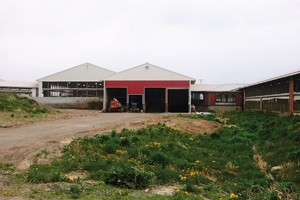 Lamb Farms Lamb Farms |
The separation equipment at New York dairy operation Lamb Farms is a key part of its manure management approach, a system that sees the dairy farm using an underground pipe network to pump liquid manure to field locations, rather than hauling it by road.
Lamb Farms Inc partner Jim Veazey likes to think of the dairy’s manure management system as a work in progress. At present, this New York state dairy continues to spread a portion of its manure directly on cropland, while processing another portion through a solid separation system before spreading it on cropland. The eventual goal is to build and operate a manure digester to manage the 197,000 tons of manure the dairy generates yearly.
The dairy—one of the state’s largest—owns 4,200 Holstein cows and is a partnership between the Lamb and Veazey families. That’s a far cry from the fewer than 100 milk cows that Gordon and Leslie Lamb started out with in the mid-1960s. The dairy business progressed quickly with Jim Veazey becoming a partner in 1977. Cornell University grad and second-generation Lamb family member Jonathan Lamb and his brother, Mathew, have now taken over the Lamb portion of the partnership. Today, the farm also raises alfalfa, wheat, and various vegetable crops on its 6,000 acres, while leasing another 2,500 acres.
Veazey and Lamb oversee a dairy business that milks three times a day on two sites. One is a 60-stall rotary parlor and the other is a twin double 10-herringbone parlor. The dairy farm also includes a heifer facility.
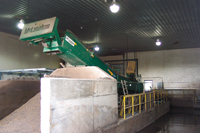 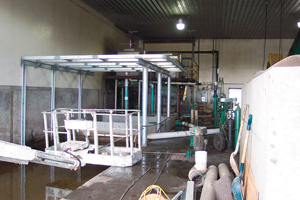 The equipment at Lamb Farms includes a McLanahan sand separator (left). The underground liquid manure piping system (right) keeps manure hauling and application equipment off the increasingly busy highways in the area. The equipment at Lamb Farms includes a McLanahan sand separator (left). The underground liquid manure piping system (right) keeps manure hauling and application equipment off the increasingly busy highways in the area. |
Veazey says the dairy business installed its first manure separation system in 1986. That was also about the same time that it started installing an underground pipe network to pump its liquid manure to various field locations, instead of hauling it there. The dairy’s main motivation for installing the pipe network was limiting its liability. The operation had grown to the point where using the road system to transport the volume of manure it was generating for spreading on nearby farms was becoming a liability issue. It now has installed about six miles of underground pipe. Many equipment changes and upgrades have also occurred to the manure separation system since the mid-1980s.
“We installed this underground piping and separation system to keep our manure hauling and application equipment off the highway because the traffic is getting so bad,” says Veazey. The dairy is located about half way between two major cities, Buffalo and Rochester. “It’s getting tougher and tougher to go down the road with our equipment.”
Solids separation was critical to the efficient management of the pipe network because solids removal makes it easier to pump the liquid manure to field outlets. In addition to easier transport, removal of a portion of the solids from the manure also helps reduce anaerobic activity in the dairy’s holding lagoon, thus reducing the potential for odor.
“My goal is to eventually build a methane digester and run our manure through that,” says Veazey. “It will eliminate manure odor, and allow us to make compost that we can use as bedding and possibly sell to some neighboring cash crop and vegetable producers.” Right now, given the moisture and nutrient content of the solids and liquids generated by the manure separator, they are still limited to using the manure as fertilizer. He expects that the dairy may invest in a digester within three years.
Veazey says that to this point, the dairy’s manure separation system has worked well, although they are working to reduce the percentage of solids still being transported to the lagoon.
The separation system receives material from two different input points because one barn uses sand for bedding while another uses sawdust. The dairy needs to remove as much of the sand from that manure stream as possible before co-mingling the remaining manure solids with the sawdust manure stream.
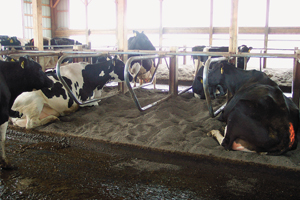 About 75 percent of the sand is reused as bedding. Lamb Farms allows the sand to drain for seven to 10 days before reusing. About 75 percent of the sand is reused as bedding. Lamb Farms allows the sand to drain for seven to 10 days before reusing. |
Veazey says sand is a superior bedding material to sawdust, but it is a challenging material to work with. “The sand is really an ideal system for cow health because it isn’t an organic material like sawdust, so you don’t have the bacterial growth,” he says. “However, it’s not a cheap system.”
The sand’s abrasive quality means it can be hard on equipment and has the potential to clog up the dairy’s underground piping system. So most of it must be removed from the manure prior to the solids separation process.
To accomplish that task, Lamb Farms has installed a McLanahan sand separator. McLanahan is based in Hollidaysburg, Pennsylvania. With roots in material separation equipment since 1886, McLanahan launched its agricultural machinery
systems division in 1996.
While the farm was planning to implement some changes to its system, with the set-up they had in place as of the spring of this year an auger conveys the sand-laden manure at a controlled rate into the sand/manure separator from a holding pit below the unit. Clean water is injected at the top of the separator at a rate of two to five gallons per minute, while recycled water from the dairy’s lagoon is injected at the bottom at a rate of 100 gallons per minute.
Settled sand is conveyed up the sand separator by a mining duty auger. It
consists of a steel pipe shaft with continuous spiral steel screw flights equipped with wear-resistant wear shoes. The sand augers up the separator and drops into
a pile at the end of the auger. At that point, it has moisture content of 10 to
12 percent.
The manure effluent flows over a rear weir, down the side channel of the sand separator, out the rear discharge pipe of the machine, and circles through the settling basin to a receiving pit below the floor where it is joined by manure from the wood shavings bedding barn. About 75 percent of the sand is reused as bedding, while 25 percent escapes the system, ends up in the solids pile or in the lagoon.
McLanahan recommends that the sand be allowed to drain for two to three days before putting it back into the freestall. Lamb Farms allows it to drain for seven to 10 days before use.
Settled solids and sand are cleaned out of the settling pit with a loader.
A Houle pump agitates the two manure streams in the receiving pit and a second Houle pump conveys the combined manure stream to the twin Integrity manure separation system, which is housed in a heated building. Nutrient Control Systems (NCS), of Chambersburg, Pennsylvania manufactures this separator equipment. It has been in business since the 1980s, helping its clients meet increasingly stringent environmental regulations. It started to focus on animal operations in the 1990s, adapting technologies that had already been developed in Europe to the North American agricultural market. In 2001, it negotiated exclusive manufacturing rights to certain key components that were formerly imported.
The Integrity manure separator combines both static screen and roller press technologies for efficient removal of solids. The separation process occurs within the machine to eliminate splashing. But the simple mechanical devices in the system are totally accessible beneath hinged covers. Spring-loaded rollers in the separator are adjustable to achieve desired solid content, and will harmlessly roll over foreign objects without damage to the machine. With a processing capacity of 20 to 400 gallons per minute, the Integrity separator works well with either scrape or flush manure inputs.
It is constructed entirely of heavy stainless steel and uses lubrication free bearings and rollers. NCS says it does not require frequent cleaning and is virtually maintenance free. The design is compact and efficient and is suited for year-round operation. It offers a five-year limited warranty on the separator, and the company provides models suitable for dairy, swine, poultry and confined beef and food processing plants. The manure separator from NCS is only part of a larger manure management system offered by the company.
Once through the separator, the solids collect in a pile outside the manure separation building at Lamb Farms. A front-end loader loads it into trucks that transport the solids for spreading on fields that the dairy is not able to irrigate. The spreading is done with one of three Knight manure spreaders owned by the dairy. There are two different types—an apron spreader and a side slinger.
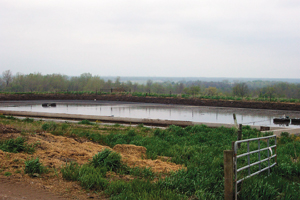 The Thefour million-gallon lagoon has three, 15-horsepower aerators, supplied by Integrity Nutrient Systems. They help to maintain the liquidity of the lagoon by keeping the water at the top. |
The liquid manure from the separator building is pumped to a long, tapered, cement-settling basin where it overflows into a four million-gallon lagoon. This lagoon has three, 15-horsepower aerators on it, which were supplied by Integrity Nutrient Systems. They help to maintain the liquidity of the lagoon by keeping the water at the top. The water off the top of this lagoon is pumped down to the separator building and into the bottom injectors of the sand separator. It is critical to keep the water fairly free of solids to maintain the effectiveness of the sand separator. A portion of the liquid manure also overflows this lagoon into the main 12 million-gallon storage lagoon where it is pumped to fields along the underground pipe network.
Once in the field, the liquid manure is injected into the soil using a Hydro Engineering drag hose system. It consists of a flexible hose connected to an aboveground pipe outlet, which is connected on the other end to a flow meter and injection system on a tractor. The tractor pulls the drag hose across the field and injects the manure into the soil.
Veazey says the dairy is continually making changes to improve its separation system. At present, it is working toward drying down its solids even more so that it can stockpile the solid material rather than having to transport and apply it year round. In terms of uniqueness, he says other large dairies in the area have manure management systems, but they are not separating out the solids, as is the case at Lamb Farms.